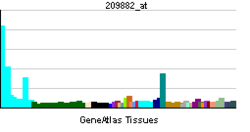RIT1
| RIT1 | |||||||||||||||||
|---|---|---|---|---|---|---|---|---|---|---|---|---|---|---|---|---|---|
| |||||||||||||||||
| Identifiers | |||||||||||||||||
| Aliases | RIT1, NS8, RIBB, RIT, ROC1, Ras like without CAAX 1 | ||||||||||||||||
| External IDs | MGI: 108053 HomoloGene: 56003 GeneCards: RIT1 | ||||||||||||||||
| Genetically Related Diseases | |||||||||||||||||
| Conduct disorder[1] | |||||||||||||||||
| |||||||||||||||||
| RNA expression pattern | |||||||||||||||||
 | |||||||||||||||||
| More reference expression data | |||||||||||||||||
| Orthologs | |||||||||||||||||
| Species | Human | Mouse | |||||||||||||||
| Entrez | |||||||||||||||||
| Ensembl | |||||||||||||||||
| UniProt | |||||||||||||||||
| RefSeq (mRNA) | |||||||||||||||||
| RefSeq (protein) | |||||||||||||||||
| Location (UCSC) | Chr 1: 155.9 – 155.91 Mb | Chr 3: 88.72 – 88.73 Mb | |||||||||||||||
| PubMed search | [2] | [3] | |||||||||||||||
| Wikidata | |||||||||||||||||
| View/Edit Human | View/Edit Mouse |
GTP-binding protein Rit1 is a protein that in humans is encoded by the RIT1 gene.[4][5][6]
RIT belongs to the RAS (HRAS; MIM 190020) subfamily of small GTPases (Hynds et al., 2003).[supplied by OMIM][6]
Clinical significance
Mutations in RIT1 are associated to Noonan syndrome .[7]
Interactions
RIT1 has been shown to interact with KLHL12[8] and Merlin.[9]
References
- ↑ "Diseases that are genetically associated with RIT1 view/edit references on wikidata".
- ↑ "Human PubMed Reference:".
- ↑ "Mouse PubMed Reference:".
- ↑ Lee CH, Della NG, Chew CE, Zack DJ (Nov 1996). "Rin, a neuron-specific and calmodulin-binding small G-protein, and Rit define a novel subfamily of ras proteins". J Neurosci. 16 (21): 6784–94. PMID 8824319.
- ↑ Wes PD, Yu M, Montell C (Jan 1997). "RIC, a calmodulin-binding Ras-like GTPase". EMBO J. 15 (21): 5839–48. PMC 452332
 . PMID 8918462.
. PMID 8918462. - 1 2 "Entrez Gene: RIT1 Ras-like without CAAX 1".
- ↑ Gos, M; Fahiminiya, S; Poznański, J; Klapecki, J; Obersztyn, E; Piotrowicz, M; Wierzba, J; Posmyk, R; Bal, J; Majewski, J (2014). "Contribution of RIT1 mutations to the pathogenesis of Noonan syndrome: Four new cases and further evidence of heterogeneity". American Journal of Medical Genetics Part A: n/a. doi:10.1002/ajmg.a.36646. PMID 24939608.
- ↑ Rondou, Pieter; Haegeman Guy; Vanhoenacker Peter; Van Craenenbroeck Kathleen (Apr 2008). "BTB Protein KLHL12 targets the dopamine D4 receptor for ubiquitination by a Cul3-based E3 ligase". J. Biol. Chem. United States. 283 (17): 11083–96. doi:10.1074/jbc.M708473200. ISSN 0021-9258. PMC 2431063
 . PMID 18303015.
. PMID 18303015. - ↑ Huang, J; Chen J (Jul 2008). "VprBP targets Merlin to the Roc1-Cul4A-DDB1 E3 ligase complex for degradation". Oncogene. England. 27 (29): 4056–64. doi:10.1038/onc.2008.44. PMID 18332868.
Further reading
- Shao H, Kadono-Okuda K, Finlin BS, Andres DA (1999). "Biochemical characterization of the Ras-related GTPases Rit and Rin.". Arch. Biochem. Biophys. 371 (2): 207–19. doi:10.1006/abbi.1999.1448. PMID 10545207.
- Shao H, Andres DA (2000). "A novel RalGEF-like protein, RGL3, as a candidate effector for rit and Ras.". J. Biol. Chem. 275 (35): 26914–24. doi:10.1074/jbc.M002241200. PMID 10869344.
- Strausberg RL, Feingold EA, Grouse LH, et al. (2003). "Generation and initial analysis of more than 15,000 full-length human and mouse cDNA sequences.". Proc. Natl. Acad. Sci. U.S.A. 99 (26): 16899–903. doi:10.1073/pnas.242603899. PMC 139241
 . PMID 12477932.
. PMID 12477932. - Hynds DL, Spencer ML, Andres DA, Snow DM (2004). "Rit promotes MEK-independent neurite branching in human neuroblastoma cells.". J. Cell. Sci. 116 (Pt 10): 1925–35. doi:10.1242/jcs.00401. PMID 12668729.
- Li JT, Liu W, Kuang ZH, et al. (2004). "[Mutation and amplification of RIT1 gene in hepatocellular carcinoma]". Zhonghua Yi Xue Yi Chuan Xue Za Zhi. 21 (1): 43–6. PMID 14767908.
- Shi GX, Andres DA (2005). "Rit contributes to nerve growth factor-induced neuronal differentiation via activation of B-Raf-extracellular signal-regulated kinase and p38 mitogen-activated protein kinase cascades.". Mol. Cell. Biol. 25 (2): 830–46. doi:10.1128/MCB.25.2.830-846.2005. PMC 543422
 . PMID 15632082.
. PMID 15632082. - Barrios-Rodiles M, Brown KR, Ozdamar B, et al. (2005). "High-throughput mapping of a dynamic signaling network in mammalian cells.". Science. 307 (5715): 1621–5. doi:10.1126/science.1105776. PMID 15761153.
- Benmaamar R, Pagano M (2006). "Involvement of the SCF complex in the control of Cdh1 degradation in S-phase.". Cell Cycle. 4 (9): 1230–2. doi:10.4161/cc.4.9.2048. PMID 16123585.
This article is issued from Wikipedia - version of the 6/5/2016. The text is available under the Creative Commons Attribution/Share Alike but additional terms may apply for the media files.